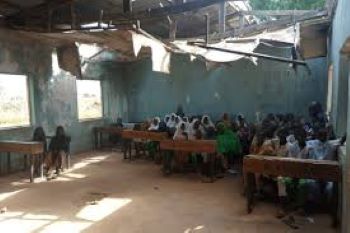In Sokoto, the quest for quality education faces significant challenges due to poor infrastructure. Despite efforts to improve educational access and outcomes, inadequate facilities, lack of resources, and infrastructure deficits continue to hinder the education sector’s progress.
By Abdallah el-Kurebe
Delving into the critical nexus between poor infrastructure and quality education in Sokoto, data from the Global Partnership for Education (GPE) highlights the multifaceted challenges faced by students, teachers, and the community at large.
According to GPE Nigeria (2011-2020 report), among the major challenges to quality education in Sokoto state are “…fewer schools to accommodate all eligible children, inadequate teachers in quality and quantity, especially in the areas of science and technology, and dilapidated infrastructures.”
This challenge refers to the condition of the existing infrastructural facilities vis-à-vis their availability and usability, about the student population. It also refers to the laboratory facilities, library space and utilization as well as the age and state of these physical facilities.
In the area of availability and state of educational infrastructural facilities in Sokoto state, the challenge includes the inadequate number of classrooms at almost all levels. There are for instance 353 Early Childhood Care Development and Education (ECCDE) centers available compared to 1,963 required. Provision of classrooms in the primary, junior secondary school (JSS) and senior secondary school (SSS) stood at 45%, 67% and 67% of the required. The average teacher-student ratio is put at 1:47 primary, 1:35 JS and 1:33 SS respectively. Again, the supply of pupils’ furniture in these classrooms as at 2009/2010 stood at 45% for primary schools and 75% each for junior and senior secondary schools in the state.
Additionally, the state of the learning environment is a major challenge in the availability and utilization of educational infrastructural facilities. This is characterized by the poor state of recreational and sporting facilities. The supply of WASH facilities is also another challenge area. There are for instance, a total of 53,569 toilets in all primary schools in the state for an enrolment of 610,886. Water and power supply to schools is minimal, especially in the rural areas.
ALSO READ Sokoto governor sacks 23 LG education secretaries
According to the United Nations Educational, Scientific, and Cultural Organisation (UNESCO), many schools in Sokoto lack basic amenities such as classrooms, desks, chairs, and adequate lighting. GPE supports UNESCO’s position by asserting that “The inadequacy of facilities in schools is again another major challenge hindering meaningful access to educational opportunities. It has been observed that only about 45% of primary school classes and about 75% each of JSS and SSS classes have adequate classroom furniture.”

This creates substandard learning environments that impede student engagement and academic performance. Overcrowded classrooms exacerbate the problem, as students struggle to concentrate amidst noise and distractions. Additionally, the absence of essential facilities like libraries, laboratories, and computer rooms limits students’ access to educational resources and opportunities for research and digital literacy.
The United Nations Children’s Fund (UNICEF) reports that rural communities in Sokoto suffer disproportionately from infrastructure deficits. Many schools in these areas lack basic amenities due to neglect, underinvestment, and geographical isolation. Poor road networks further isolate rural schools, making it difficult for students and teachers to access educational opportunities and resources. As a result, students in rural areas face significant barriers to quality education, perpetuating socioeconomic inequalities and hindering their prospects.
The poor infrastructure also affects the quality of teaching and learning in Sokoto. According to data from GEP, teachers struggle to deliver effective lessons in substandard facilities, limiting their ability to engage students and facilitate meaningful learning experiences. The lack of teacher training facilities and professional development opportunities further exacerbates the problem, as educators grapple with limited resources and support to enhance their pedagogical skills and instructional practices.
UNESCO says that the cycle of poor infrastructure perpetuates socioeconomic inequalities in Sokoto. Inadequate education infrastructure hampers human capital development, economic growth, and social progress. Without access to quality education and the opportunities it provides, marginalized communities are left behind, further exacerbating existing disparities and hindering the nation’s overall development.
ALSO READ VIEWPOINT: Will Nigeria meet education components of SDGs?

Therefore, addressing the nexus between poor infrastructure and quality education requires a comprehensive approach. Policymakers should prioritize investment in education infrastructure, including school construction, renovation, and maintenance, to create conducive learning environments for students and teachers.
Also, adequate resources and funding should be allocated to address infrastructure deficits in rural areas, ensuring equitable access to quality education for all communities. Additionally, teacher training programs and professional development initiatives should be enhanced to equip educators with the skills and support needed to deliver high-quality instruction in challenging environments.
The impact of poor infrastructure on quality education in Sokoto is a pressing issue that demands urgent attention and action. By addressing infrastructure challenges, policymakers can pave the way for a more inclusive, equitable, and prosperous society where every child has the opportunity to fulfil their potential.
Failure to act risks perpetuating the cycle of poverty and underdevelopment, undermining the nation’s aspirations for socioeconomic advancement. Stakeholders must prioritize education infrastructure as a cornerstone of Sokoto’s development agenda, investing in the future of its children and the prosperity of the nation.

